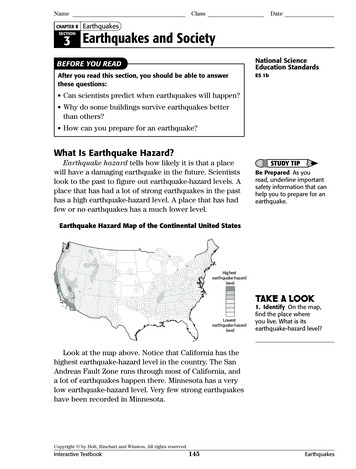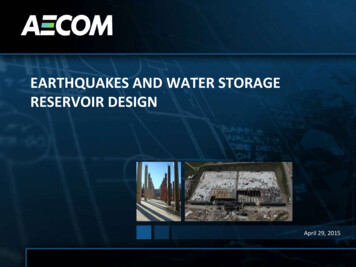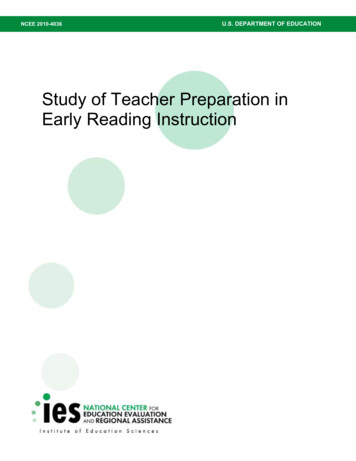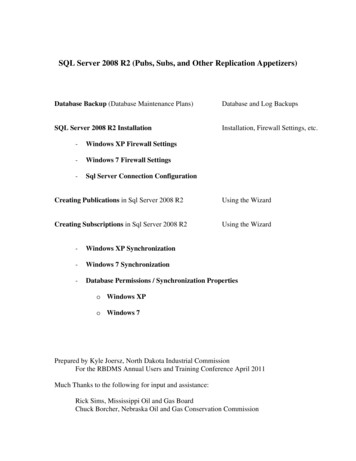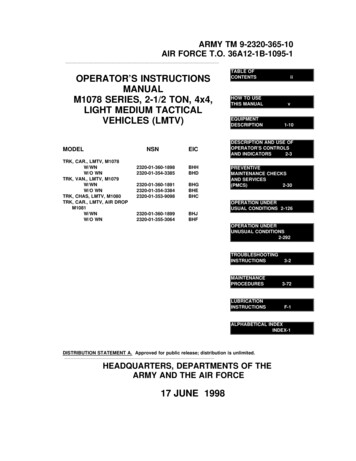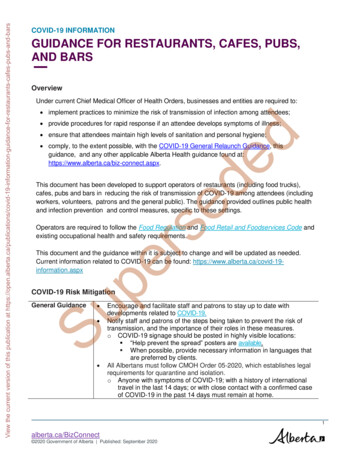
Transcription
DEPARTMENT OF THE INTERIORU.S. GEOLOGICAL SURVEYUnited States Earthquakes, 1953ByLeonard M. MurphyWilliam K. CloudOpen-File report 84-953Prepared in cooperation with National Oceanic and Atmospheric Administration,This report has not been reviewed for conformity with U.S. Geological Surveyeditorial standards.1984
CONTENTSPageIntroduction.Earthquake information services- -- --Modified Mercalli Intensity Scale of 1931 -- -------- --- .-.-.-------. -.----- -Epicenter maps.Teleseismic results. . . . . . * . . . . . .Magnitude-intensity correlation. - - - - - - - ---- - -- Strong-motion seismograph results,Earthquake historyNoninstrumental results.-- - -Earthquake activity in the various States.Earthquake activity outside the United States.Northeastern regionEastern region.Central region.Western mountain region---- - - --- - - - - - - - - - - - -- - California and western Nevada.Washington and Oregon.Alaska .----.- - ---- - -24Hawaiian Islands.Panama Canal Zone- - - - - - ---- ---- - -- - - -2729Puerto Rico. ---29Miscellaneous activities. - -- - - - - - - - . - - - - Geodetic work of seismological interest -- -- - - . -- - Tidal disturbances of seismic originFluctuations in well-water levels.IntroductionWell descriptions.Table 1. Fluctuations in well-water levels, January 1 through December 31, 1953Seismological observatory results.-- --- .- ---Summary of instrumental epicenters for 1951.Table 2. Principal earthquakes of the world from January through December 1953.--Strong-motion seismograph results.IntroductionTable 3. U. S. Coast and Geodetic Survey strong-motion stations in operation as ofDecember 31,1953 -------- - .- - - - --- - - - -Table 4. List of shocks recorded and records obtained on strong-motion seismographs in1953Table 5. Summary of outstanding instrumental and noninstrurnental data for 1953.---.Table 6. Composite of strong-motion instrumental data for 1952 -Tilt observationsCorrections to previous editions. -- - ----- -- . - - - - -Publication notice .292929303030314041424343---------- .-- -- -- - ---- --1123334455577891124-----44454649515151
ureFigure1. Destructive and near destructive earthquakes in the United States through 1953.2. United States earthquake epicenters, 1953- --------- -- ---------- --3. Area affected by earthquake of June 13 . - -- . . - -.4. Area affected by earthquake of September 25 .- - - .- -5. Area affected by earthquake of December 16 . ---- ,- - - --- - --.6. Area affected by earthquake of December 15.7. Tracings of accelerograph records obtained at San Jose, Costa Rica, on January 7;at Lima, Peru, on February 15; at Guatemala City, Guatemala, on August 24Figure 8. Tracings of accelerograph and displacement meter records obtained at El Centro,California, on June 13Figure 9. Tracings of accelerograph record obtained at Santiago, Chile, on September 4 .vr616192325474849
FIGURE 1. Destructive and near destructive earthquakes In the United States through 1953.U. S. COAST AND GEODETIC SURVEYDEPARTMENT OF COMMERCECOMPILED BYDESTRUCTIVE ANDNEAR DESTRUCTIVE EARTHQUAKESOF THE UNITED STATES THROUGH 1953
UNITED STATES EARTHQUAKES, 1953INTRODUCTIONThis publication is a summary of earthquake activity in the United States andregions under its jurisdiction for the calendar year 1953. The sources of noninstrumental information used in the compilation include the United States Weather Bureau,whose observers prepare periodic reports on local seismic activity; telegraphic information collected by Science Service, Washington, D. C.; Bulletins of the SeismologicalSociety of America; special reports of the Jesuit Seismological Association and theNortheastern Seismological Association; the Hawaiian Volcano Letter; newspaper clippings; and reports from interested individuals. Instrumental data used in locatingearthquakes are obtained from the network of Coast and Geodetic Survey stationslisted on page 40 and from other cooperating Seismological stations in the United Statesand throughout the world.The Coast and Geodetic Survey endeavors to coordinate efforts in collecting alltypes of earthquake information with the special object of correlating instrumentalearthquake locations with noninstrumental reports received from the epicentral areas.This is done by local organizations making intensive regional investigations in California and elsewhere, and, when necessary, by the Coast and Geodetic Survey. Thisinformation serves to adequately map the seismic areas of the country and promotepublic safety through a better understanding of earthquake phenomena. Since thesuccess of the general information service depends largely on the cooperation of localofficials and citizens, all are urged to fill out and return earthquake questionnaires.Earthquake information services. The Coast and Geodetic Survey maintains aSeismological Field Survey in San Francisco to collect earthquake information andmake field investigations of strong shocks in the Pacific coast and western mountainStates. Details concerning damage, destruction, and other effects are enumerated inthe quarterly Abstracts of Earthquake Reports for the Pacific Coast and the WesternMountain Region. This report is available on request from the Director of the Coastand Geodetic Survey, Washington 25, D. C. Active cooperation in this work isreceived from the University of California Seismographic Station, Berkeley (Dr. Perry63 3', in charge); and the Seismological Laborato , Pasadena (Dr. Beno Gutenberg,Director); as well as State Collaborators in Seismolog3r. The following Collaboratorsserved as agents of the Coast and Geodetic Surve\T in their respective States in 1953:Arizona. Dr. Eldred D. Wilson, University of Arizona, Tucson.Colorado. Prof. C. A. Heiland, Heiland Research Corp., Denver. (lontana. Prof. Stephen W. Nile, Montana School of Mines, Butte.Nevada. Dr. David B. Slemmons, University of Nevada, Reno.New Mexico. Prof. Stuart A. Northrop, University of New Mexico, Albuquerque.Oregon. Dr. Ira S. Allison, Oregon State College, Corvallis.Utah. Prof. J. Stewart Williams, Utah State Agricultural College, Logan.Washington. Prof. Howard A. Coombs, University of Washington, Seattle.Wyoming. Prof. Horace D. Thomas, University of Wyoming, Laramie.1
2U. S. COAST AND GEODETIC SURVEYAmong the commercial agencies on the west coast rendering valuable services aretelephone, power, oil, railroad, and especially insurance companies. Certain concernsinterested in the manufacture of earthquake-resistant building materials are also activetogether with various organizations of structural engineers and architects.In other parts of the country the Jesuit Seismological Association with centraloffice at St. Louis University collects information in the central Mississippi Valley area(Rev. Dr. James B. Macelwane, S. J., Dean of the Institute of Technology). TheNortheastern Seismological Association with headquarters at Weston College, Weston,Mass. (Rev. Daniel J. Linehan, S. J., in charge), undertakes similar work in the northeastern States.Modified Mercalli Intensity Scale of 1981. All intensities used by the Coast andGeodetic Survey refer to the Modified Mercalli Intensity Scale of 1931. 1 The abridgedversion of this scale is given here with equivalent intensities according to the RossiForel scale.MODIFIED MERCALLI INTENSITY SCALE OF 1931(ABRIDGED)I. Not felt except by a very few under especially favorable circumstances. (I Rossi-Forel scale.)II. Felt only by a few persons at rest, especially on upper floors of buildings. Delicately suspendedobjects may swing. (I to II Rossi-Forel scale.)III. Felt quite noticeably indoors, especially on upper floors of buildings, but many people do notrecognize it as an earthquake. Standing motorcars may rock slightly. Vibration like passingof truck. Duration estimated. (Ill Rossi-For.il scale.)IV. During the day felt indoors by many, outdoors by few. At night some awakened. Dishes,windows, doors disturbed; walls make creaking sound. Sensation like heavy xruck strikingbuilding. Standing motorcars rocked noticeably. (IV to V Rossi-Forel scale.)V. Felt by nearly everyone, many awakened. Some dishes, windows, etc., broken; a few instancesof cracked plaster; unstable objects overturned. Disturbance of trees, poles, and other tallobjects sometimes noticed. Pendulum clocks may stop. (V to VI Rossi-Forel scale.)VI. Felt by all, many frightened and run outdoors. Some heavy furniture moved; a few instancesof fallen plaster or damaged chimneys. Damage slight. (VI to VII Rossi-Forel scale.)VII. Everybody runs outdoors. Damage negligible in buildings of good design and construction;slight to moderate in well-built ordinary structures; considerable in poorly built or badlydesigned structures; some chimneys broken. Noticed by parsons driving motorcars. (VIIIRossi-Forel scale.)VIII. Damage slight in specially designed structures; considerable in ordinary substantial buildingswith partial collapse; great in poorly built structures. Panel walls thrown out of framestructures. Fall of chimneys, factory stacks, columns, monuments, walls. Heavy furnitureoverturned. Sand and mud ejected in small amounts. Changes in well water. Personsdriving motorcars disturbed. (VHI-f- to IX Rossi-Forel scale.)IX. Damage considerable in specially designed structures; well-designed frame structures thrownout of piumb; great in substantial buildings, with partial collapse. Buildings shifted offfoundations. Ground cracked conspicuously. Underground pipes broken. (IX-f- RossiForel scale.)X. Some well-built wooden structures destroyed; most masonry and frame structures destroyedwith foundations; ground badly cracked. Rails bent. Landslides considerable from riverbanks and steep slopes. Shifted sand and mud. Water splashed (slopped) over banks.(X Rossi-Forel scale.)XI. Few, if any, (masonry) structures remain standing. Bridges destroyed. Broad fissures inground. Underground pipelines completely out of service. Earth slumps and land slips insoft ground. Rails bent greatly.XII. Damage total. Waves seen on ground surfaces. Lines of si ht and level distorted. Objectsthrown upward into air.1 Modified Meroalli Intensity Pcale of 1931.tol. SI. \o. 4, Dfcrrnlicr 1931.Harry O. Wood and Frank Neumann, Btdldin of the Sfisrnoloyical Society of. 1 rnericn,
UNITED STATES EARTHQUAKES,19533Epicenter maps. Figure 1 is designed to show the existence of destructive andnear destructive earthquakes in the United States through 1953. The smallest dotindicates the shock was strong enough to overthrow chimneys or affect an area ofmore than 25,000 square miles (intensity VII to VIII); the largest solid dot may beassociated with damage ranging from several thousand dollars to one hundred thousanddollars, or to shocks usually perceptible over more than 150,000 square miles (intensityVIII to IX); the smaller encircled dots represent damage ranging from approximatelyone hundred thousand to one million dollars, or an affected area greater than 500,000square miles (intensity IX to X); the larger encircled dots represent damage of amillion dollars or more, or an affected area usually greater than 1,000,000 square miles(intensity X to XII).Figure 2 shows earthquake distribution in the United States during 1953. In afew cases where instrumental control is not satisfactory or where results of investigations are inadequate, the plotted epicenters should be considered as showing the existence of the earthquake rather than the precise location.In figures 1 and 2, those earthquakes occurring in the California area are plottedwhen felt reports are received from several places. Earthquakes reported as feebleare not plotted on the epicenter map of the United States, nor are minor aftershocksplotted for heavy earthquakes in California or any other region. The number after adot indicates the number of shocks which have occurred at or near the location shown.Bulletins of the University of California Seismographic Station, Berkele3T, and the Scismological Laboratory, Pasadena, should be consulted for further details regardingepicenters and often for data on additional shocks.The selection of isoseismal or "felt area" maps (figs. 3-6) is governed largely bythe size of the area affected, the minimum radius generally being of the order of 50miles. In the case of sharp localized shocks this means that some earthquakes of intensity VI (mostly in California) will not be shown on such maps whereas others ofintensity IV and V (largely in the eastern and central areas) will be shown.Teleseismic results. On page 40 is a list of Survey and cooperating teleseismicstations for which the Survey publishes results. During the ye&r the locations of 176epicenters were announced promptly on Preliminary Determination of Epicenter cardsand an additional 543 locations were reported weekly on Supplement cards. Thosedesiring to receive these cards should request addition of their name to the PDE mailing list. All seismogram interpretations are published in the quarterly SeismologicalBulletin, MSI series, available on mailing list CGS-7 from the Director, U. S. Coastand Geodetic Survey, Washington 25, D. C. During the year 1954, MSI-129 through132 for the first through the fourth quarter 1947, MSI-133 for the first quarter 1948and MSI-157 through 108 for the monthly bulletins of 1954.Maf/nitwie-intenftity correlation. Magnitude, given according to the RiehterGutenberg scale, is used extensively as a measure of the energy of an earthquake atthe focus. An explanation of this scale is given in the Bulletin of the Seist/ioloi/icalSociety of America, volume 32, Xo. 3, 1942. This scale, derived from an empiricalformula based on instrumental results, should be distinguished from the intensity scalewhich is a measure at any distance from the focus of the effects on animate and inanimate objects, including damage to buildings. The following comparison is givenbetween the magnitude and intensity designations for normal depth earthquakes insouthern California.Magnitude. 2. 2 3456788.5M-M Intensity. 1.5 2.8 4.5 0.2 7.8 9.5 11.2 12.0
4U. S. COAST AND GEODETIC SURVEYStrong-motion seismograph results. The maintenance of a network of strongmotion seismographs and analysis of the records of destructive earthquake motionsthus obtained are functions of the Bureau in connection with a broad cooperativeprogram of research being carried out on the Pacific Coast with a number of localorganizations and institutions interested in the engineering aspects of the earthquakeproblem. The details of this program are described in S. P. 201, Earthquake Investigations in California, 1934-35.The preliminary analyses of strong-motion records are published in the QuarterlyEngineering Seismology Bulletin which is available upon request from the Director,U. S. Coast and Geodetic Survey, Washington 25, D. C. The revised analyses aregiven in table 1.Earthquake history. A history of the more important shocks of the country appearsin Serial 609, Earthquake History of the United States. Part I covers continental UnitedStates and Alaska, exclusive of California and western Nevada; Part II covers thestronger earthquakes of California and western Nevada. The first part was revisedin 1947 and the latter in 1951.A history of minor activity is covered largely in a series of references listed inSerial 609, in recent reports of the Coast and Geodetic Survey, and in the Bulletin ofthe Seismological Society of America, volume 29, No. 1, January 1939. The last tworeferences give detailed information for all California earthquakes. The last onecontains all information appearing in early catalogs published by the SmithsonianInstitution.A summary of the earthquake program as carried out in the United States isbriefly outlined in S. P. 282, Earthquake Investigation in the United States, revised 1953.The major organizations and stations are listed together with a list of the independentand/or privately operated stations. This publication is available from the Superintendent of Documents, Government Printing Office, Washington 25, D. C., for 20 cents.
NONINSTRUMENTAL RESULTSNOTE. The following symbols are used to indicate authority for times or reported epicenters: P, reported by the Seismologies)Laboratory, California Institute of Technology, Pasadena; B, reported by the Seismographic Station, University of California,Berkeley; BC, reported by the Boulder City office of the United States Coast and Geodetic Survey; NESA, reported by the Northeastern Seismological Association, Weston, Mass.; JSA, reported by the Jesuit Seismological Association, St. Louis, Mo.; and W,reported by the Washington Office, United States Coast and Geodetic Survey.An asterisk (*) indicates instrumental origin time of the earthquake when coordinates of the epicenter are given. Otherwise,instrumental times shown with asterisks are those of first motions.When more than one degree of intensity is reported from a town, the town is listed under the highest intensity reported. Moredetails will be found in the quarterly Abstracts of Earthquake Reports for the Pacific Coast and the Western Mountain Region, MSAseries, issued on mailing list CGS-S by the United States Coast and Geodetic Survey, Washington 25, D. C.EARTHQUAKE ACTIVITY IN THE VARIOUS STATESNOTE. The intensities of the earthquakes for which no ratings are given range from I to IV.Arizona: May 4, III; October 8, V.Arkansas: May 12, III.California: (Intensity V and above) February 3, V (2); 19, V; March 5, V; 16, V; 21, V; April28, V; May 1, V; 24, V, Vl' (2); June 13, VII; October 7, V; 13, V; 21, V; November 12, V; 23, V (2);December 15, V; 16, VI.Connecticut: March 27. V.Idaho: September 9, IV.Illinois: September 11, VI; December 30, IV.Kentucky: December 31, IV.Missouri: February 11, IV.Montana: March 8, IV; May 11, III; August 7, IV; 8, VI, II; 14, IV; 15, IV (2); November23, V.Nevada: February 3, 15, 16; 28, III; March 2, IV; 9, IV; 10, IV; 21, V; 24, III; 25, III; April10; May 3, 12, 18 (2); 19, IV; 22, 24; July 12. IV; 13, III; September 18, III; 25, VI; 28, III; October9, IV, III; 11, IV; 12, 13, III.New Hampshire: May 11, IV.New Jersey: August 16, IV.New York: April 25, IV.Ohio: May 7, IV; June 11, IV.Oklahoma: March 16; 17, VI; June 6, IV.Oregon: November 4; December 15, VI.South Dakota: December 21; December 31, IV.Tennessee: January 26; February 17, IV; 18, IV; November 10, IV.Utah: April 17, IV; May 23, V; July 29, V; August 16, IV; October 21, V; 24.Vermont: March 30, III; 31, V.Virginia: February 7, IV.Washington: February 24, IV; April 10, IV; 27, III; May 26, IV; July 11.Wyoming: March 15, IV; April 26, IV; June 4, IV.EARTHQUAKE ACTIVITY OUTSIDE THE UNITED STATESAlaska: January 11, 16 (2), 28, 29; February 5, 13; 18, IV; 19, 21; March 5, 16; April 9, 10, 13,19, 21, 25; May 5, 7, 12, 14, 19, 20, 23, 27; June 9 (2), 19, 20, 27; July 4, 17, 19, 23, 26, 31; August 28;September 12, 20, 22, 27, 28; October 7, 8, 13, 15, 22; December 4, 15, 17 (2), 18.Hawaii: January 3 (2), 7, 8, 9 (4), 13, 15 (2), 23; February 12, IV; 22; March 6 (2), 23, 25, 26,27; April 10, 14, 24; May 19, 22, 24 (2), 25, 26, 27, 29; June 4, 9, 15, 27; July 15, 26 (2), 28; August 1,4, 6, 8, 21 (2), 23, 24; September 3, 23, 27; October 2, 8, 9 (2), 15, 22, 27 (4), 28 (4), 31; November 2228, 29 (2), 30; December 1, 9, 16.Panama Canal Zone: January 20, V; February 7; March 19, II; August 4, II; September 1, IIPuerto Rico: February 21; July 6.
I,.[1-,,V'Earthquakes of intensity I-VEarthquakes of intensities VI-VIIIEarthquakes of intensities IX-XIISmall figure indicates number of earthquakes reported duringthe year. No figure indicates one shock only, except for minorfore- and aftershocks.ri0 */-«*-.1f' .: *;FIGURE 2. United States earthquake epicenters, 1953.Cft
UNITED STATES EARTHQUAKES, 19537NORTHEASTERN REGION(75TH MERIDIAN OR EASTERN STANDARD TIME)March 27: 03:50. Stamford, Conn. V. Quake shook southwestern Connecticut and adjacent Westchester County. Many awakened and frightened at Stamford; police switchboards flooded.Many homes jarred; two story brick building trembled; radiators beat a weird tattoo against floorof police station. At Greenwich felt by a,nd alarmed many; sounded like a double explosion; surfacesounds (creaking of buildings and rattling of buildings) heard by many. At New Canaan few awakened; buildings creaked and loose objects rattled. A sump pump in cellar was thrown out of position fell to the north. Felt by and awakened several at Darien and Norwalk. At Wilton felt byseveral and scattered reports of rumbling sounds. In New York several awakened and frightened atPort Chester and felt at Harrison (by many), Mamaroneck, and Rye.March 30: 21:50. Brandon, Vt. III. Slight foreshock of the following west-central Vermont earthquake. Felt by several.March 31: 07:59:06*. West-central Vermont. V. F3lt strongly along a 40-mil.} path extending from Brandon on the north to Ludlow and Weston on the south. Recorded by the seismograph stations at Burlington, Vt., and Weston, Mass.INTENSITY v:Rutland. Felt by many; awakened and frightened few. Some furniture moved; houses quivered; sounded like furnace exploded or truck crashed. Felt with varying degrees of intensities withinthe city limits.Brandon. Awakened many (in Brandon State School), and frightened many. Small objectsmoved; houses trembled; water spilled; knickknacks fell.INTENSITY IV:Leicester. Felt by several and frightened few. Rattled windows and dishes; rumbling heardby many.Ludlow. Felt by many. Rattled windows, dishes and stove lids. Felt like vibrations of aheavy truck.Pittsfield. Felt by many; frightened all who heard it.Pittsford. Felt by many; frightened few. Several objects disturbed and buildings creaked.Proctor. Felt by all; frightened many.Randolph. Felt by many; frightened few. Windows and dishes rattled.Rochester. Felt by all. Felt like a heavy truck.Weston. Felt by few. Dishes rattled.Woodstock. Felt by many. Moved vase on table; trees shaken slightly. Car felt as if itshivered.INTENSITY IV IN NEW YORK:Comstock. Felt by few. Rattled windows.Whitehall. Felt by few. Rattled windows.INTENSITY i TO in: Bethel, Bridgewater Corners, Castleton, Fair Haven, Mendon Mountain,North Clarendon, Norwich, Plymouth, Springfield, Tyson, Wallingford, West Rutland, and Windsor.INTENSITY i TO in i\ NEW YORK: Granville.April 25: 20:20. Plattsburgh, N. Y. IV. Felt by many. Many calls to newspapers andpolice and radio stations. Sounded like a slight rumble or explosion. Also felt at Ausable Forksand Cadyville (one instance of cracked plaster).May 11: 01:13:17*. Conwaj, N. H. IV. Epicenter placed in the Conway-Ossipee area bythe Weston Observatory. At Conway awakened few and felt by several. Mirror in dresser rattled.At Madison awakened, frightened and felt by few. Lasted several seconds and rattled windows.Also felt at Silver Lake (2 miles from Madison), North Sandwich, and Tainworth.EASTERN REGION(75TH MERIDIAN OR EASTERN STANDARD TIME)February 7: 03:00 (about). Goochland-Cumberland County border, Va. IV. Felt in smallarea near Goochland-Cumberland County border. Felt by many at Cartersville, New Canton, RockCastle, Pemberton, and Sabot where reports were received of buildings and windows shaking, heavyearth rumbling, and sounds like explosion. At Richmond, report of a house and bed tremblingviolently.
8U. S. COAST AND GEODETIC SURVEYAugust 16: 23:22:50*. Bergen County, N. J. IV. Felt in most of Bergen County, somenorthern New Jersey communities and adjoining areas of Rockland and Westchester Counties, NewYork and Morningside Heights, a section of New York City. In New Jersey, felt by many andaccompanied frequently by sound effects at Closter, Dumont, Fairview, Garfield and Haworth. Inaddition, at Hackensack, dishes rattled and calls swamped police headquarters: at New Milford fewalarmed and houses shook; at Oradell many observed disturbed objects and slight swaying of trees.In New York at Irvington felt by several; rattling of loose objects; swaying of lamps, tables, andash trays; sounded like an explosion.Intensity I to III in New Jersey at Bergenfield, Bogota, Hoboken, Cliffside Park, Cresskill,Edgewater, Fort Lee, Leonia, Northvale, Norwood, Ridgefield, Ridgefield Park, Rochelle Park,and Teaneck.Intensity I to III in New York at Larchmont, Yonkers, Yorktown Heights, Sloatsburg, andTarrytown.CENTRAL REGION(90TH MERIDIAN OR CENTRAL STANDARD TIME)January 26: 17:18*. Finley, Tenn. Centered near Finley and also felt in Boothspoint andLane. The St. Louis and Florissant seismographs recorded faint traces.February 11: 04:50:54*. Epicenter 36.5 north, 89.5 west, New Madrid, Mo., JSA. IV. Reports of intensity IV from Dorena, Kewanee, Marston, New Madrid, Parma, Point Pleasant, andRisco, Missouri, and Hornbreak, Trigrett, and Tiptonville, Tennessee, where dishes and w ndowsrattled, houses shook and few awakened. Also felt in Catron, Conran, Gobler, Hermondale, Lilbourn,and Tallapoosa, Missouri; Hickman, Kentucky; and Elbridge, Tennessee.February 17: 05:45 and 18:17. Finley, Tenn. IV. Felt by several. Windows and dishesrattled in some homes.February 18: 23:05. Finley, Tenn. IV. Windows rattled in several homes. Durationonly a few seconds.March 16: 06:50. Union City, Okla. Slight tremor felt.March 17: 07:12 and 08:25. Concho, Okla. VI. Felt by many inside. Minor damage;foundation, garage floor, and plaster cracked at one location. Dishes moved on table; picture twistedon walls; sensation of building coming down. Intensity V in Union City where several felt the shock.Dishes broke; houses quivered; kitchen cabinet doors shook open. In Minco felt by several; timealarm set off; dishes rattled on table and table and floor trembled. In Okarche light fixtures swayedto north and coffee in cups rippled. Felt by several in El Reno and Piedmont, and felt in Calumetand Edmond.May 7: 17:32. Crooksville, Ohio. IV. Startled many residents. Windows and dishesrattled; buildings quivered in the downtown area; sounded like a distant explosion. Ohio Powerbuilding shook. Also felt on a hill a mile south of the power building and in Roseville.May 12: 12:50. Lepanto, Ark. III. Felt by several. Felt as one quick jolt lasting lessthan a second. One report of floor shaking.June 6: 11:40. Ada, Okla. IV. Felt by several. Duration about 15 seconds. Windowsrattled.June 11: (p. m., no time given). Toledo, Ohio. IV. Pictures knocked off walls in Toledoand suburbs; hundreds of telephone calls to police and newspapers. Houses shaken in Adams,Springfield and Sylvania.September 11: 12:26:28*. Epicenter 38.6 north, 90.1 \vost, southwest Illinois, JSA. VI.Minor damage occurred in Roxana when cement block foundations and plaster cracked. Cans andjars knocked off grocer's shelves. Intensity V in Edwardsville where many rushed to the streetfrom the courthouse and other downtown buildings and in Mitchell where cans fell off a refrigeratorand strong vibrations were reported.INTENSITY iv: Alhambra, Aviston, Belleville, Bethalto, Caseyville, Centerville Station, Collinsville, Columbia, Cottage Hills, Coulterville, East Alton, East Carondelet, Glen Carbon, Godfrey,Hartford, Hecker, Hoylcton, Lebanon, Marine, Marvville, Mascoutah, Millstadt, Xew Baden,O'Fallon, Radom, Sparta, St. Jacob, Summerfield, Troy, Venice, Wood River, and Worden.INTENSITY iv IN MISSOURI: Berkeley, Bridgeton, Florissant, House Springs, St. Louis, WestAlton, and Winfield.INTENSITY i TO in: Addieville, Bartelso, Beckemeyor, Breose, Bunker Hill, Carlyle, East St.Louis, Freeburg, Grafton, Mount Olive, Mulberry Grove, Now Memphis, Pocohontas, Trenton, andWilsonville.
UNITED STATES EARTHQUAKES, 19539INTENSITY i TO in IN MISSOURI: Festus, and Maryland Heights.- November 10: (about 10:00). Knoxville, Tenn. IV. Windows rattled and ground shook.Other reports from Burlington and Inskip.December 21: 16:43. Zeona, S. D. The shock, reported by a single observer, caused considerable vibration of a house and table and was accompanied by a heavy rumbling sound. An oilprospecting crew was operating in the area but the observer who was well acquainted with theirarea of operation, felt that this disturbance was a natural earthquake.December 30: (about 16:00). Centralia, 111. IV. Slight tremor shook Centralia, nearbyCarlyle, and Mount Vernon. Windows were shaken and a "loud rumble" was reported by many.December 31: 14:30. Burke, S. D. IV. Several reported explosionlike noise, shaking ofthe ground, and rattling of doors and windows. Also reported at Jamison, Nebr.December 31: 20:30. Woodland Park, Ky. IV. Felt by several in Woodland Park. Reportof house and chest shaking and furnace switching on. Also felt in Allais and Hazard.WESTERN MOUNTAIN REGION(105TH MERIDIAN OR MOUNTAIN STANDARD TIME)Februarys: 11:48:15*. Boulder City, Nev. Felt slightly.February 15: 20:11:58*. Boulder City, Nev. Felt by one person.February 16: 00:27:16*. Boulder City, Nev. Felt by one person.February 28: 13:45:05*. Boulder City, Nev. III. Felt by several.March 2: 13:46:40*. Boulder City, Nev. IV. Felt by many.March 8: 18:39:34*. Helena, Mont. IV. Felt by many. Buildings creaked; loose objectsrattled. Some people were alarmed and a few left theater. Main feature was the loud rumblingand bumping subterranean sounds heard before, during, and after shock. Felt by several at Austinabout 10 miles northwest of Helena.March 9: 20:05:20*. Boulder City, Nev. IV. Felt by nearly all. Windows and doorsrattled.March 10: 22:24:14*. Boulder City, Nev. IV. Felt by many.March 15: 08:30. Alta, Wyo. IV. Felt by many. Buildings creaked; loose objects rattled.Thunderous subterranean sounds h
of truck. Duration estimated. (Ill Rossi-For.il scale.) IV. During the day felt indoors by many, outdoors by few. At night some awakened. Dishes, windows, doors disturbed; walls make creaking sound. Sensation like heavy xruck striking building. Standing motorcars rocked noticeably. (IV to V Rossi-Forel scale.)
